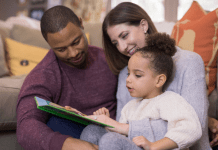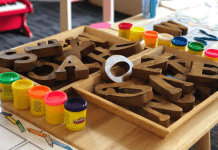This editorial series, Hot Topics, is brought to you by the Fort Worth Moms Blog and iCare Emergency Room & Urgent Care. All 15 original articles from the Hot Topics series can be found on our website.

I am a white mama.
I am a white mama of white children.
And if you’re a white mama of white children, I am writing this mostly to you. I am writing this to you because I struggle with how and when to talk to my kids about race. I thought that maybe if I am struggling, you might be too. I want to get this right. I know you do, too. If your kids are young like mine, they may have never mentioned race. They choose playmates without regard to skin color. They have no prejudices, no biases. But our kids are not colorblind. They do notice differences. So we need to give them the words to talk about race and the freedom to have the conversation with us.
This week I had a heart-to-heart with an expert on the topic, Dr. Brigitte Vittrup. She is a professor of early childhood development and education at Texas Women’s University. Vittrup is also a mom of mixed-race children, and she has spent much of her career researching the racial attitudes of children. Talking to her gave me some guidance, a path to follow on the road to raising race-conscious kids. Our conversation was eye-opening and encouraging. Here are some of the things I learned.
We need to have these conversations with our kids. In the absence of the conversation about race, our kids fill in the blanks with messages from the world around them. Those messages are generally wrong. Even children’s books and cartoons can reinforce stereotypes. Our kids need guidance. I would never leave it up to our society to teach my kids about the important stuff — faith, manners, morality, finances, or sex. So I can’t leave the race conversation to anyone else. It’s that important.
For younger kids, we can easily communicate about race with concepts they understand. Dr. Vittrup elaborates: “They understand the concept of fairness, you know, with some people not being given the same opportunities or some people not getting as much . . . . They understand the concept of just being nice.”
For older children, she says “as they get older, they’ll start to understand more complex concepts about stereotypes, discrimination, and bias.”
 We need to start early. Dr. Vittrup recommends starting these conversations when our kids are babies. She explains, “The earlier you start these conversations, it becomes just normal for them to talk about it, and they’re more likely to ask questions when they have questions.”
We need to start early. Dr. Vittrup recommends starting these conversations when our kids are babies. She explains, “The earlier you start these conversations, it becomes just normal for them to talk about it, and they’re more likely to ask questions when they have questions.”
Another point here is not that our babies are noticing race and ethnicity, but that WE need time to get used to talking about it openly. Have a conversation about the Chinese character in the book you are reading. Talk about the lovely brown skin of the girl in the cartoon. Explain that even though her skin is brown, we use the word black when referring to her race. Openly discuss unfair portrayals and racial stereotypes you see in books and movies. If you’re like me and your kids are no longer babies, it’s not too late to start. Just start now.
Seek out diversity. Let’s face it; even in 2018, our world can still be segregated. Our neighborhoods, schools, and churches are often segregated. We can still see the effects of our country’s long history of discrimination. Sometimes we have to be intentional to expose our kids to people who don’t look like them. Vittrup recommends that “taking kids to areas outside of the neighborhood, where they . . . can get visual exposure to people who look different.”
It’s okay to state facts. It’s normal for our kids to simply notice race in the world around them, especially things they have never seen or heard before — interracial relationships, a white mom with a black child, or a child speaking Spanish. Kids are curious. They like to ask questions and point out things. Loudly. In public. And you don’t need to shush them if they are just stating fact.
Yes, she is black, and her mama is white. You could add: “We don’t have to look the same to be a family. Isn’t that neat?” You could also point out that we don’t know who is family just by looking, because all families look different. We need to practice using appropriate, but explicit, language to answer our kids and show them we are comfortable and competent talking about race and discussing our differences. Which leads me to my next point.
We need to BECOME comfortable and competent talking about race and discussing our differences. We have to educate ourselves. This is a worthwhile area in which to invest your time and brainpower. Read about racism in America, historical and modern day. Read firsthand experiences of interracial families. Learn about the experiences of immigrants. And then take that knowledge, compassion, and perspective and pass it along to your kids. Here are some ways you can start.
- Read books. For you, try The New Jim Crow by Michelle Alexander and Why Are All the Black Kids Sitting Together in the Cafeteria? by Beverly Daniel Tatum, Ph.D. For young children, Dr. Vittrup recommends the books All the Colors We Are — The Story of How We Get Our Skin Color by Katie Kissinger and Shades of People by Shelley Rotner
- Listen to podcasts. This one from The Longest, Shortest Time blog is particularly helpful. Dr. Vittrup is the guest on this show!
- Visit websites. Vittrup recommends raceconscious.org, embracerace.org, and teachingforchange.org. If you want to know specific phrases you can use with your children about race-related topics, these are the places to go.
This is a hard subject to know how to talk about; I know it is. But research shows that parents of color are three times more likely to discuss race than white parents. We can do better, mamas. For the sake of all children, I know we can.














First of all, why would you want to point out that someone is different because of his/her skin color to your baby or toddler when he/she believes that everyone is the same (like we all should believe)? I think you should definitely wait until they start asking questions. Yes, they do notice differences but it means nothing to them, which is exactly the way it should be, not only to them but to all of us.
Second of all, you should have emphasized that when you choose to teach your kids about race, it is important to let them know that we are all the same regardless of our skin color. I know you meant to get at that when you talked about not having to look the same to be a family, but I feel that this point should have been a lot more explicit. We should focus on our similarities rather than differences. Yes, history and social issues are important, however, the future is much more crucial. Imagine if we all taught our children that the color of one’s skin has nothing to do with one’s character, personality, etc, and that we are all exactly the same besides our assorted colors. If kids of all races were raised to believe that, there would be more harmony and equality in the future.
Kudos to you for writing about such a touchy subject though.